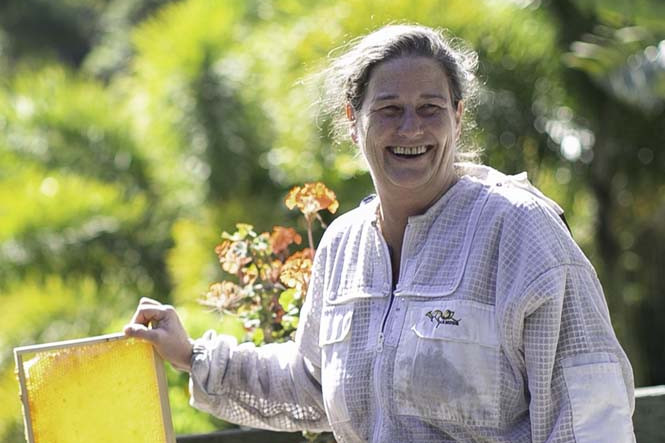On The Land
8 February, 2024
World-class honey here on Tablelands
WHEN Honey House Kuranda owner Trish Green purchased her first beehive and her business in January 2007, after having worked for the previous owners, it was for a surprising reason.

“My interest was more about the importance of bees as pollinators and their benefits for sustainable ecosystems,” Trish said.
“Honey has always been a bonus commodity.”
Honey House Kuranda has developed a world famous reputation for producing the highest quality honey ever since the business commenced in 1959 with the aim of showcasing and promoting the many distinctive honeys from North Queensland.
“The honey is sourced either from our hives or through our long established relationships with other beekeepers in the area which align with our philosophy,” Trish said.
“Our apiary sites are all located in the Kuranda region and produce a variety of honeys including - Rainforest, Eucalypt, Garden Medley, Cadagi, Lychee, Fruit Tango, Sarsaparilla, Forest Blossom and a variety of multi-floral honeys named for the area the apiary is situated in.
“We have exported to Japan, Hong Kong, Singapore, the United States, Germany and the United Kingdom.”
The special requirements needed to produce honey include strong, healthy colonies of bees, good floral sources, a clean environment with no pesticides, a good water source, a patient and calm beekeeper and also a substantial amount of specialised equipment and tools.
The colour and flavour of different honeys are directly related to the original nectar source. Honey colours vary from very pale (white) through to very dark (black).
“Avocado honey, rainforest honey and many bush (mixed blossom) honeys are black in colour, with a corresponding deep flavour,” Trish said.
“Ironbark, Grey Box and Molloy Box are lighter in colour, have ‘toffee’ sweetness, but also their own distinctive, more subtle flavours.”
Each harvest is individually cold-extracted and bottled, so every purchase is unique.
The production of one kilogram of honey requires foraging visits to about one million blossoms. It takes approximately 12 bees’ life work to make a teaspoon of honey. Therefore, approximately 720 bees would be required to produce a 300 gram jar of honey.
“Our honeys are valued for their guarantee of quality,” Trish said.
“Our beekeeping management practices follow Small Harvest Policy Practices to ensure that the health and strength of the bee colony is paramount to the enterprise.
“We never harvest more than half of the available honey stores from the hive, selecting individual frames that are fully capped.
“Capped honey is the beekeeper’s clue to the ripeness of the crop.
“Although this method is much more labour intensive, it ensures the bees have adequate food supplies.
“We do install plantings on each apiary site to ensure there is forage available all year round for our bees.
“I do not follow migratory beekeeping practices (i.e. I do not move my bees seasonally to follow flowering flows) so we must ensure healthy food sources for our bees all year round.”
The honey operation employs various strategies to help it cope with excessive wet weather and cyclones.
“Wet weather and cyclones do affect the production of honey and can affect the strength of the colony,” Trish said.
“Prolonged wet weather knocks the nectar out of the flowers which means there is nothing for the bees to forage on.
“It also affects pollen production which in turn means the bees have limited pollen sources - pollen is the protein food for the bees.
“To alleviate this food issue, we do not ‘rob’ (i.e. harvest) any honey from the hives before the onset of a prolonged wet season. This ensures there is enough food in the hive to keep the colony strong and healthy.
“High winds can knock hives over and potentially drown a colony. To mitigate this, we take all our hives off the hive stands and place them on the ground, prior to a cyclone. We did not lose any hives from Cyclone Jasper.
“The longevity of the business is unique in Australia and brings with it 65 years of knowledge about our North Queensland honey industry.
“I am lucky enough to have relationships with past owners who have all been supportive to me and happy to give advice and information, especially when I was starting out.”
Production can vary from nil (in a very bad year) to over a tonne. It depends on the weather, the flowering patterns of source flora, the strength of the colonies, the health of the colonies, and the number of hives at any particular apiary site.
“Due to the age of the business, we do have an excellent reputation for supplying the best honeys from the region,” Trish said.
“Demand is steady, especially with long-standing, repeat customers (local, regional, intrastate, interstate and international).
“We prefer to present the product as the bees have made it without any adulteration.
“We do, however, produce a range of infused honeys such as cinnamon infused, ginger infused and chilli infused.
Trish said the rewarding aspects of her work include being able to provide a truly healthy, locally produced super food to the consumer.
“To know that our products are not only delicious but also great for people’s health and are ethically produced is a wonderful way to maintain a business,” she said.
For further information, go to www.honeyhouse.com


